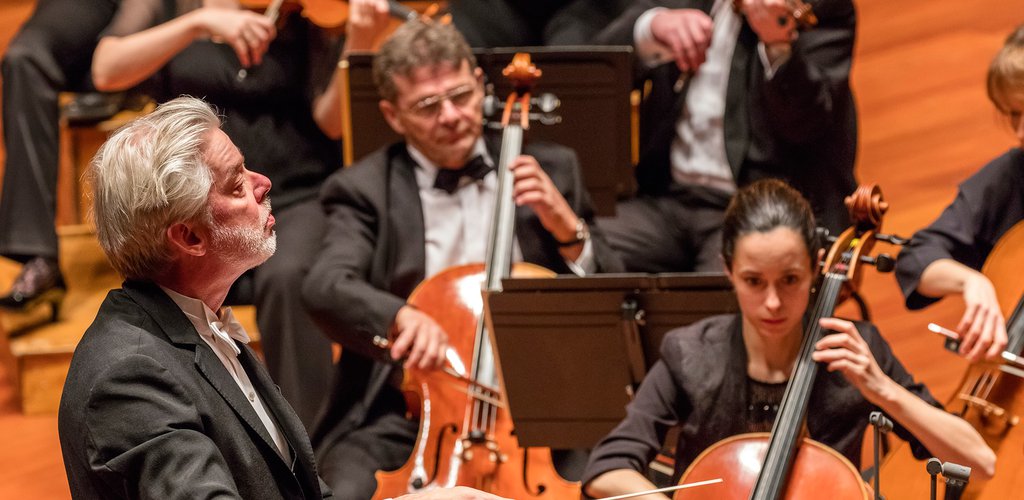The first number was a no-longer-that-contemporary composition by Magnus Lindberg, Feria, which premiered almost forty years ago. Reminiscent of Gershwin, Stravinsky, and the best of film-score writers, the work found an audience fascinated from the first bar. I don’t think I could recognise any part of it if I heard the piece on the radio, but it was a good little number for warming up and entertaining – even if, truth be told, it was about twice as long as strictly necessary.
It allowed the conductor to demonstrate his and the orchestra’s virtues – his explicit and energetic approach, and the well-balanced sound which does not intrude on the grand tuttis, respectively.
I last saw Christian Tetzlaff in concert more than a decade ago, at the Academy of Music. Then he played Mendelssohn’s Violin Concerto, quite beautifully. But instead of the well-groomed, eminent violinist in his student-glasses who took the stage back then, by now his style has become rather more ‘hip’ (I’m no expert in men, but I do know something about marketing) with a goatee, long hair, and a carefree and confident demeanour. In Dvořák’s Violin Concerto there may in fact be some infinitesimal need for such captatio benevolentiae. I suspect that if the ‘good, clumsy kid’ of some ten years ago had taken the stage this time, he would have found it more difficult to enthuse the audience with this rather beautiful, although not consistently exciting, work. I know this is subjective, but I also feel that the Piano Concerto in G major is somewhat over composed, and the Violin Concerto also has few real climaxes or catchy melodies, with only the third movement really selling itself.
Tetzlaff’s performance (as we have become accustomed to in other genres, such as chamber music) was as well-mannered as usual, but he appeared unable to raise the sound of the piano above that of the orchestra. Besides that, it looked like he was trying to avoid playing like a metronome; I wouldn’t say his playing was sloppy, but he handled the tempos rather freely and ‘breathed’ too much, even between beats. In contrast, Saraste provided a much more regular accompaniment, but still the result did not sound disconnected; that’s to say, Saraste’s square manner and Tetzlaff’s free interpretation both remained within a certain common denominator. However, I still think a more empathetic conductor could have provided a broader spectrum of emotions for the work as a whole, and that being the case we would probably have judged Tetzlaff’s performance more memorable as well. In the encore of the Bach Largo we received a noble, heartfelt and introspective interpretation, leaving us to think that maybe today’s Tetzlaff is the make-believe one.
Sibelius’ name was the one that enticed me the least in the run-up to the concert. I have had some markedly bad experiences with his Second Symphony. Of the old performers I hold in high esteem, neither Toscanini nor Beecham could convince me; I remember back in the day when some of us sat listening to this music, and the fantastic Mihály Lackó actually called it second-rate. These youthful experiences can cast a shadow over a composition for a lifetime, or at least until we encounter an opposing experience. Something of this sort of thing happened with Saraste and the Festival Orchestra’s performance, and even if it didn’t immediately turn me into a Sibelius fan, it made me reconsider my judgement of the Second Symphony. I genuinely enjoyed the first movement; this is where I felt that Saraste was most at home, undaunted by too many emotions. And even if the other movements didn’t electrify me in the same way, and even if I still feel that the fourth movement is over composed, I can say this was a sound performance.
Finally, though, I would like to say a few words about the orchestra. A united string sound is a pre-requisite in today’s world, but it is still worth recognising the amount of effort required from concert to concert, that it is not just routine work. The same can be said about the brass section’s nuanced sound and the professionalism of the entire orchestra.
READ THE ORIGINAL ARTICLE THROUGH FIDELIO (IN HUNGARIAN).

